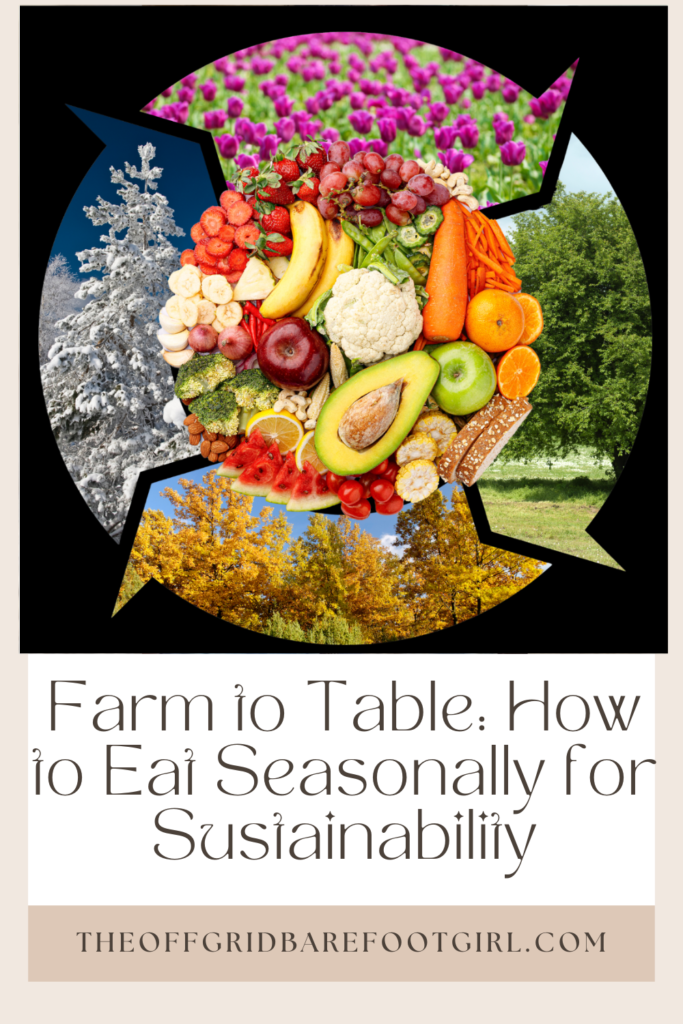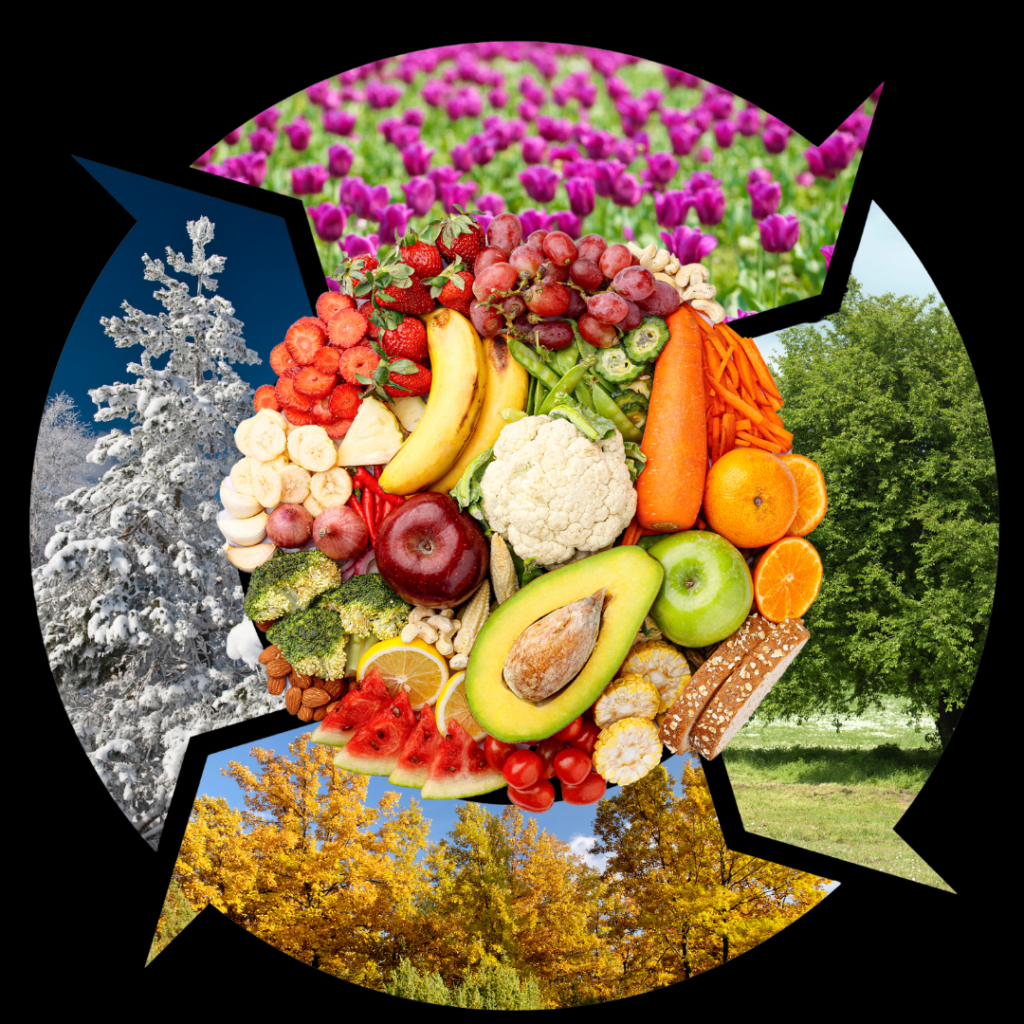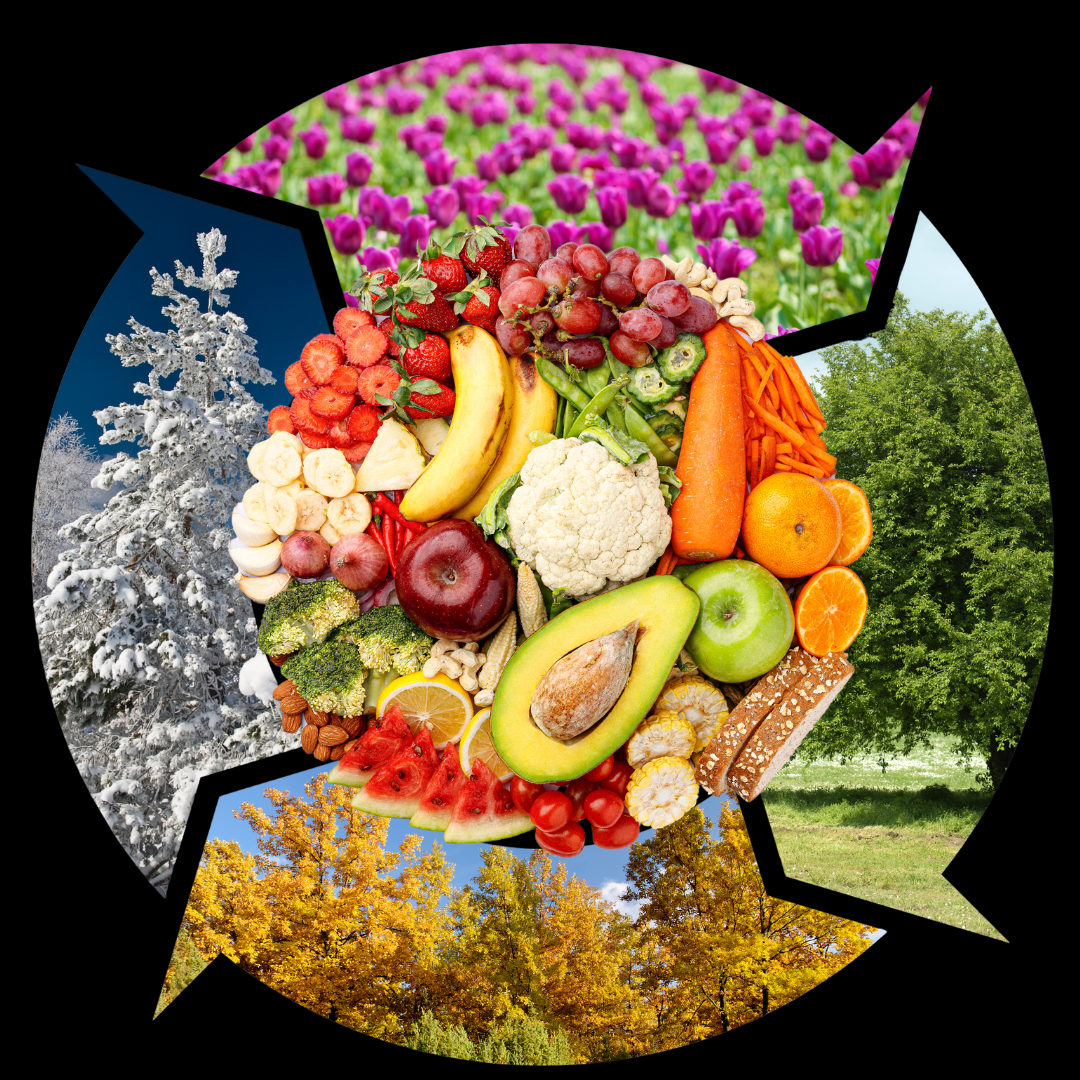Discover the benefits of eating seasonally with a farm-to-table approach. Learn how to choose fresh, local produce, support sustainable farming, and enjoy healthier, eco-friendly meals all year long.
In today’s world, where environmental concerns are paramount, the farm-to-table movement has gained significant traction. Eating seasonally not only supports local farmers but also reduces the carbon footprint associated with transporting food across long distances. In this blog post, I’ll explore the principles of eating seasonally, the benefits of this approach, and practical tips for incorporating seasonal foods into your diet. I will share the ideas of the Farm-to-Table Movement and provide additional resources. Additionally, I’ll highlight some affiliate products from Amazon that can enhance your seasonal cooking experience.
This is a pinnable post. Tap or hover over any image in this post to pin to your Pinterest Boards.

Understanding the Farm-to-Table Movement

The farm-to-table concept emphasizes sourcing food directly from local farms, ensuring freshness, quality, and sustainability. This approach minimizes the time between harvest and consumption, preserving the nutrients and flavor of produce. Eating seasonally aligns with this movement, as it encourages you to choose foods that are in their peak season, often resulting in better taste and nutrition.
Benefits of Eating Seasonally
- Nutritional Value: Seasonal produce is often fresher and more nutrient-dense than out-of-season options, which may have been harvested weeks or months earlier.
- Environmental Impact: Eating foods that are in season locally reduces the need for long-distance transportation, thus lowering greenhouse gas emissions associated with food transport.
- Supporting Local Economies: Purchasing from local farmers helps sustain community economies and promotes the use of sustainable farming practices.
- Flavor and Quality: Fruits and vegetables harvested at their peak season are typically more flavorful and have better texture compared to their out-of-season counterparts.
How to Identify Seasonal Foods
To effectively eat seasonally, it’s important to know which foods are in season in your region. This can vary based on climate, geography, and local farming practices. Here’s how you can identify seasonal produce:
- Local Farmer’s Markets: Visiting farmers’ markets is a great way to learn about what’s in season. Farmers can provide insight into what produce is currently being harvested.
- Seasonal Produce Guides: Use seasonal produce calendars that outline which fruits and vegetables are in season month by month. You can find several of these guides available for download or purchase on Amazon. This one is very cute and is a fridge magnet!
Seasonal Calendar Fridge Magnet!
Discovering the Joy of Seasonal Eating: Lessons from My Backyard Orchard and Survival Garden
Starting my backyard orchard and survival garden has completely transformed how I approach food, teaching me to embrace the rhythms of each season. I began growing my own fruits and vegetables as a way to be more self-sufficient, but what I didn’t expect was the way it would reconnect me to the natural cycles of food production.
Now, instead of relying on store-bought produce year-round, I look forward to the unique flavors and freshness that each season brings—from the juicy berries of summer to the hearty root vegetables of winter. Seasonal eating has become a rewarding part of my lifestyle, not just because it’s healthier and more sustainable, but because it adds variety and a special appreciation for every meal.
Unlocking the Secrets of a Thriving Backyard Orchard and Survival Garden: Essential Resources and Tips
If you’re interested in learning more about how to cultivate and maintain a thriving backyard orchard and survival garden, the links below are packed with valuable content about my gardens. These resources cover everything from selecting the best fruit tree varieties and vegetables for your climate to sustainable gardening practices that can help you make the most of each season.
You’ll find practical tips on soil health, organic pest management, crop rotation, and even techniques for preserving your harvest. Whether you’re a beginner or looking to expand your gardening skills, these articles are an excellent guide to making your backyard orchard and survival garden flourish year-round.
My Written Resourceful Content is Just for You!
Tips for Eating Seasonally

- Plan Your Meals: Create a meal plan around seasonal produce. This helps reduce food waste and encourages creativity in the kitchen. Invest in a Meal Planning Journal to keep track of seasonal recipes and your grocery list. Check out the Meal Planner Notebook available on Amazon.
- Join a Community Supported Agriculture (CSA) Program: Participating in a CSA allows you to receive a regular supply of seasonal produce directly from local farms. Enhance your cooking with a CSA Cookbook that offers recipes specifically designed for seasonal produce.
- Preserve Seasonal Foods: When certain fruits and vegetables are in peak season, consider canning, freezing, or dehydrating them for later use. Look into a Canning Kit or Food Dehydrator to help preserve your seasonal bounty. These can be found on Amazon and are perfect for extending the life of your harvest.
Cooking Seasonally: Recipes to Try
Now that you understand the benefits and strategies for eating seasonally, let’s explore some delicious recipes that highlight seasonal ingredients.
Spring: Asparagus and Pea Risotto
As spring arrives, fresh asparagus and peas are in abundance. This creamy risotto is a delightful way to celebrate the season.
Ingredients:
- Arborio rice.
- Fresh asparagus.
- Green peas.
- Vegetable broth.
- Parmesan cheese.
- Onion and garlic.
Use a Cast Iron Skillet to make this risotto for even cooking. Check out options on Amazon.
Summer: Heirloom Tomato Salad
Summer brings a variety of colorful heirloom tomatoes, making it the perfect time for a fresh salad.
Ingredients:
- Heirloom tomatoes.
- Fresh basil.
- Mozzarella cheese.
- Balsamic glaze.
A Salad Spinner can help rinse and dry your greens and herbs efficiently. You can find quality ones on Amazon.
Fall: Pumpkin Soup
As fall arrives, pumpkins become widely available. This creamy pumpkin soup is warming and nourishing.
Ingredients:
- Fresh pumpkin.
- Onion.
- Vegetable broth.
- Coconut milk.
- Spices.
A High-Quality Blender can help you create a smooth, creamy texture for your soup.
Winter: Root Vegetable Mash
Winter is a great time for hearty root vegetables like potatoes, carrots, and parsnips.
Ingredients:
- Potatoes.
- Carrots.
- Parsnips.
- Butter and cream.
A Vegetable Peeler and Potato Masher can make preparing these root vegetables a breeze.
Seasonal Eating: Shopping Tips

When shopping for seasonal produce, here are some tips to keep in mind:
- Buy in Bulk: Purchasing larger quantities when items are in season can save money and ensure you have enough for your meals.
- Be Flexible: Adjust your recipes based on what’s available. This encourages creativity and minimizes waste.
- Support Local: Whenever possible, buy from local farmers or farmer’s markets to ensure you’re getting the freshest produce.
Sustainability Practices at Home
In addition to eating seasonally, there are several sustainable practices you can adopt in your kitchen:
- Composting: Create a compost bin for food scraps to reduce waste and produce nutrient-rich soil for your garden. Check out a Compost Bin to get started on recycling your kitchen waste. I love this countertop compost bin for adding eggshells, fruit and vegetable scraps, tea bags, coffee grounds, etc! Then I just dump it out in the compost bin or the chicken run, depending on what’s inside!
- Using Reusable Containers: Reduce single-use plastics by investing in reusable containers for food storage. Look into Glass Storage Containers available on Amazon that are perfect for leftovers and meal prep.
- Grow Your Own: If you have the space, consider growing your own herbs or vegetables. This can supplement your seasonal eating and reduce reliance on store-bought products. A Gardening Starter Kit can provide you with the tools you need to begin your gardening journey.
Conclusion
Eating seasonally is not just a trend; it’s a sustainable lifestyle choice that benefits your health, local economies, and the environment. By incorporating seasonal produce into your meals, you can enjoy fresher flavors, reduce your carbon footprint, and support local farmers. With the right tools, tips, and recipes, embracing a farm-to-table approach can be a rewarding and delicious endeavor.
Eating with the seasons is easier when you have your own land—find out more in How to Live on Raw Land.
Resources: Here are some helpful resources for further information.
- The Farm-to-Table Movement – By Agritecture
- What Is the Meaning of Farm-to-Table? – By The Spruce Eats
- The Farm-to-Table Movement: A Complete Guide – By Hitchcock Farms

Frequently Asked Questions
1. What are the main benefits of eating farm-to-table?
Eating farm-to-table provides fresher and tastier produce, supports local economies, and reduces the carbon footprint associated with food transportation. Additionally, it often promotes healthier eating habits by encouraging the consumption of whole, seasonal foods.
2. How can I find seasonal produce in my area?
You can find seasonal produce by visiting local farmers’ markets, joining community-supported agriculture (CSA) programs, or checking online seasonal produce calendars. Local agricultural extension offices can also provide valuable information tailored to your region.
3. What are some easy ways to incorporate seasonal foods into my diet?
To incorporate seasonal foods, plan your meals around what’s available, try new recipes that feature local ingredients, and preserve excess seasonal produce by canning or freezing. Engaging with local farmers through markets or CSAs can also inspire new meal ideas.
4. How does eating seasonally support sustainability?
Eating seasonally supports sustainability by decreasing the environmental impact of food transportation, promoting biodiversity, and encouraging sustainable farming practices. By supporting local farms, you contribute to the local economy and help reduce food waste.
Summary
I hope I have inspired you to help you prepare your family for eating seasonally with these helpful tips and products. Here are some other links you may be interested in reading!
COVID-19 Disease X: What You Need to Know Now!
Prepare for Civil Unrest Now with These Prepping Tips!
How to Survive the Silent Killer Carbon Monoxide Poisoning
How to Do Earthquake Drills: Are You Ready to Shake, Rattle, and Roll?
Crafting the Ultimate Emergency Action Plan for Your Family
How to Create a Cozy Home Anytime of the Year!
The Best Portable Generators By Generac
Best Ideas for Backpacking Meals: Fuel Your Adventure!
End Times Headlines: How Prepared Are You Really?
Hiking the High Desert: Survival Tips You Should Never Ignore!
SHTF Planning: How to Survive the High Desert Bootcamp!
Survival Skills Training: Into the Backwoods with a Master Survivalist!
Choosing the Best Survival Cooking Kit: The Ultimate Guide
Survive the Peaks: The Best Avalanche Gear on the Market!
Bug In and Survive a Grid Down: Survival Training Course!
Bugout Bags and Survival Training Course with Grid Down Consulting!
Self-Sufficiency and Survival Posts!
Get These Vital Emergency Survival Equipment Now!
Bartering: How To Negotiate Commodities with Astonishing Results!
Warning: Why You Need Whole Home Water Purification Now!
How to Design Off Grid Power Systems for Your Homestead
How Many Watts Does a Fridge Use? Energy Efficient Guide
The Best States for Off Grid Living: Unplugged and Thriving
Composting Toilet Systems Are Surging: Ditch Your Septic Tank Now!
Are Greywater Tanks the Key to Sustainable Living? Find Out Now!
How to Live Off-Grid: 11 Tips to Survive and Thrive!
Are Survival Food Kits Worth It? The Truth Revealed!
Do You Really Need Faraday Bags? The Shocking Truth Revealed!
The Best Doomsday Preppers Blogs to Follow Now Before SHTF!
The Ultimate Camping Gear Checklist: Everything You Need for an Adventure
The Ultimate Spring Cleaning House Checklist: Deep Clean with Me!
How Supporting Farmer’s Markets Makes a Difference
Eco-Friendly Christmas: How to Have an Eco-Friendly Christmas
How to Winterize Your Home: Prepare for Jack Frost’s Wrath!
Proven Hacks to Make Your Christmas Tree Survive
What Thanksgiving Teaches Us About Survival
Homeless Survival Hacks to Overcome Adversity
More Self-Sufficiency Posts!
Is Your Car Ready for Winter? The Ultimate Checklist for Your Winter Emergency Car Kit
What The Walking Dead Can Teach Us About Survival: The Walking Dead Survival Tactics
Get Lockdown Ready: Best Dollar Tree Survival Items
Understanding Water Purification Methods for Survival: Best Practices Explained
Thirsty for Survival: Expert Guide to Emergency Water Prep Tactics
The Benefits of Urban Homesteading: Revolutionize Your City Life
Practical Pantry Prepper: Essential Guide
How to Grocery Shop Once a Month
What Should Be in A 72-Hour Survival Kit?
Buy or Die: Prepper Items You Need Now
How to Learn 58 Self-Sufficient Skills Right Now
Road to Self-Sufficiency: How to Start Your Journey
If you were encouraged by this post, I invite you to check out my FREE Printables Page for fun free printables, planners, and charts.
ENTER MY FREE Printables Page HERE
Blessings,
The Off Grid Barefoot Girl





